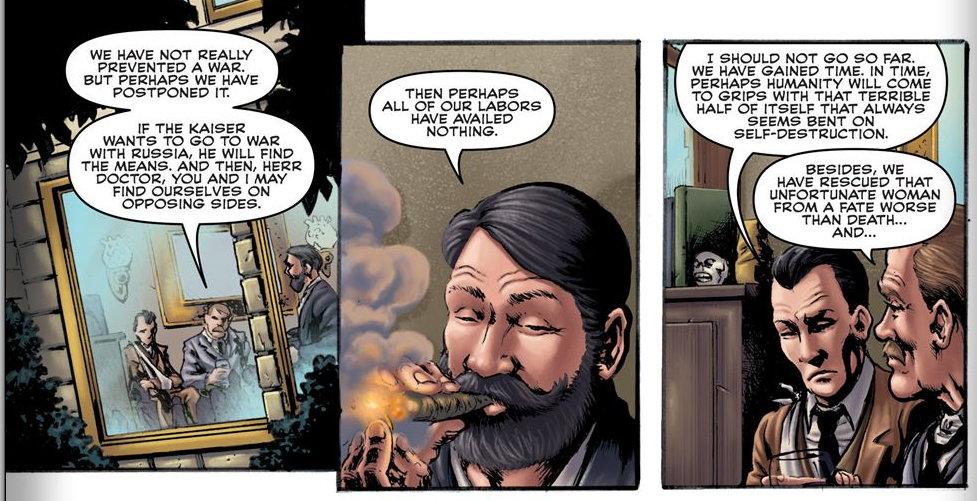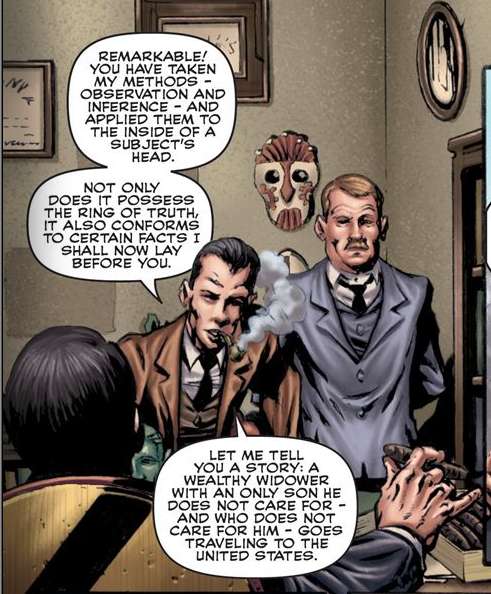A novel, and it’s three adaptations.

This 1974 novel by Nicholas Meyer is perhaps the most famous Sherlock Holmes pastiche novel. It was a best-seller when released, was partly responsible for a revival of interest in Sherlock Holmes in the 70s, and its success has inspired the publication of many, many more Holmes pastiche books.
It’s success and status in the Holmes fandom has led to it being adapted at least three times. And I’m going to talk about and review not only the novel, but also its three adaptations which have been made over the years: the 1976 film, the 1993 BBC Radio Drama and the 2016 comic book.
To discuss the story and its adaptations properly, I’m going to explain the plot, including the ending, so be warned.
The book’s take on Holmes is revisionist. It focuses on Holmes’s use of cocaine, which in the novel has by 1891 became an addiction that might kill him. Professor Moriarty being an evil criminal mastermind is Holmes’ delusion, created by his compulsive use of cocaine. In reality, Moriarty is an innocent mathematics tutor, who once taught both Sherlock and Mycroft when they were children.
To cure Sherlock of his addiction, which might soon turn fatal, Doctor Watson and Mycroft Holmes lure him to Vienna, to meet Sigmund Freud, the father of psychoanalysis. Freud is to treat and cure Holmes of his drug addiction.
After much effort by Holmes himself especially, Holmes is put on the part of recovery. Then he discovers a mystery involving one of Freud’s patients, and the game is afoot once more.
As mentioned, this book was a huge success. And it is understandable, for it is a very well-written book. Meyer’s imitation of Watson’s style is successful and feels authentic. The premise is interesting and inventive. The first part of the book, showing Holmes’ in the grips of a terrible drug addiction, his and Doctor Watson’s valiant efforts to help him recover is emotionally powerful. The close friendship between Holmes and Watson is very well depicted.
The second part of the book shows Holmes, Watson and Freud working together to solve a mystery. It is a very good mystery and is exhilarating to read about. The entire trio get to show their skills, and the idea of a team-up between Holmes and Freud is used to great effect.
It culminates in an amazing action scene with a train chase and a swordfight atop a train. The scene may be silly, complete with a “cutting up a train car for fuel” part straight out the Marx Brothers Go West, but very fun.
It has high stakes, involving a possible war in Europe, which adds to the excitement, but it still feels grounded enough to be a fitting case for Holmes. Despite the politics involved, it is still rooted in personal/psychological problems (which provides a role for Freud to make deductions of his own). Holmes is also unable to change history through his actions, he himself notes that he has at most only delayed a European war, which of course eventually broke out in 1914. This helps further ground the case in reality.
Meyer’s book is a good example of how Holmes is adapted to fit the times. Despite being a period piece set in 1891, the novel is very much a product of the 1970s. The frank depiction of Holmes’s drug use was due to a greater openness about drugs and their effects in culture at the time. The depiction of Holmes as a fallible hero due to his drug use also fit the sceptical cultural mood at the time, even if the second half re-establishes him as a heroic figure.

Holmes
philosophizing on war and violence in the comic book adaptation, as is
typical of the comic book, the words are pretty much verbatim from the
book.
The theme of the second part of the book is clearly anti-war, with the backstory involving a pacifist quaker woman trying to destroy an arms manufacturing empire and Holmes trying to stop a war in Europe. After the disaster of the Vietnam War, this fit the prevailing anti-war mood in the western world perfectly.
Of course, despite being a product of its time in these aspects, the book doesn’t feel dated for the most time, because the time period in which it was written mostly is expressed through themes. The 1891 time period, the style of the novel and the characters Holmes and Watson’s feels true to the original stories.

Holmes’s praise of Freud in the comic book adaptation, again the words are pretty much directly from the original novel.
The novel has probably dated the most in its positive depiction of Freud and his ideas. Freudianism was going through a period of popularity in the 1970s. Although I’m on the whole against freudian ideas, the depiction here wasn’t that annoying to me. I must admit that the comparisons made between Holmes’ detective work and Freud’s work are actually quite clever. Freud’s case studies read like detective stories after all (and are probably just as fictionalized).
Freud’s involvement culminates in the final twist of the novel, where Freud is able through hypnosis reveal a traumatic experience in Holmes’ childhood. His father killed his mother, due to her affair with his tutor Professor Moriarty. And the novel presents Freud’s predictable analysis of this uncritically: this traumatic event explains why he became a detective and fighter of crime, why he used cocaine, why Moriarty became a malignant figure in his delusion and so on. It’s of course silly, although it is fitting for a novel involving Freud and Holmes to end like this, with Freud’s theories being applied to the great detective.

The novel was adapted into a film directed by Herbert Ross in 1976, with a screenplay by Meyer himself. And I have mixed feelings about it. The novel is flawed, but the changes made for the film make it worse. The main problem is that they changed a lot of the mystery in the second-half. It involves an evil baron, a damsel in distress and a train chase, but there the similarities pretty much end. The book’s complex backstory involving the morality of weapons manufacturing and a possible war in Europe is jettisoned.
Instead we get a simplistic “rescue the damsel in distress” story. And it is a racist/orientalist plot as well: An evil Ottoman Pasha wants to kidnap a white woman for his seraglio. This is a massive change for the worse.
The original plot was sexist also in its “damsel in distress” nature, but it was more interesting. The themes of weapons manufacturing, a war in Europe and the woman Nancy Slater’s opposition to it raised interesting themes and raised the stakes for the story. And while she was damseled, the woman’s moral principles and intelligence was what put that plot into motion.
The film’s plot has none of those engaging features, and it is just boring and clichéd. It is racist and was extremely unoriginal even back in 1976. Also, it’s a minor and underdeveloped part of the film, but the film’s clumsy attempt to hint at a romantic relationship between Lola and Holmes was just annoying and felt out of character for Holmes.
Of course, the film has its merits as well, which is why I have mixed feelings about it. Certain aspects of the film are quite excellent. The film is very well-made overall. The direction and cinemtography is odd sometimes but conveys the suffering Holmes goes through well. The acting is excellent, especially Nicol Williamson as a Holmes in a very difficult situation. Robert Duvall’s Watson is held back by his stuffy attempt at an english accent, but his part is decent otherwise. Alan Arkin is a convincing and authorative Freud. Vanessa Redgrave is underutilized as Lola Deveareaux but she is always fun to see. We even get a bit of luxury casting with Laurence Olivier as in the small role of Moriarty.
And for certain
stretches, the film works very well. The first half or so of the film
is excellent, and adapts the novel rather closely, with only minor
and insignificant changes. The film goes off the rails in the second
half due to substituting the strong mystery of the book with a weaker
one. But the climatic train chase is on par with the one in the book
and very fun. Ridiculous, but such an entertaining and exciting
scene. Perhaps one of my favourite action scenes in cinema, if I’m to be perfectly honest.
The film is very uneven, and the changes made from the book generally only weaken the story, but there is enough good things that it can be worth watching. The climatic train scene is so fun that it makes up for the weak mystery plot that led there.
There was also a 1993 BBC radio drama adaptation of the book. It stars Simon Callow as Holmes, who also played the role in the “Unopened Case-book of Sherlock Holmes”, a series of pastiche radio dramas aired on the BBC the same year. It has almost been (unfairly) forgotten, but can be found on the OTR Researchers Library website.
This radio version takes some cues from the film in how it dramatizes the story, but as is the standard for BBC Radio adaptations of literature, much more faithful to the book and retains the mystery from it. And it is much more stronger because of that. The acting isn’t on the level of the film or the contemporary Clive Merrison/Michael Williams BBC Holmes dramas, but still quite strong. Callow is a good Holmes and Ian Hogg as Watson outdoes Duvall from the film. It is a bit rushed due to only being 90 minutes, but is an excellent and faithful version of the book that is a far less uneven experience than the film.
Similarly faithful to the book is the 2015-2016 comic book adaptation, written by Scott and David Tipton with art by Ron Joseph. The script follows the book very faithfully. There are some minor cuts to the story to make the story work as a 100 page comic, but no major changes. It is so faithful that there isn’t actually anything to say about the comic’s writing that I haven’t already said about the source material. The art is well-done and nice, even if I’m not that enamoured with how Joseph draws humans, but that is probably a taste thing.